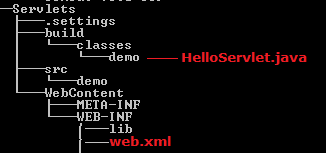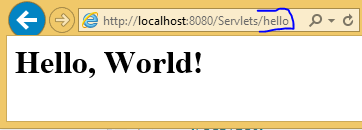Servlet Lifecycle
First we see the example, then we can understand the Lifecycle. For every Servlet program contains following strcuture

Here Servlets is Application name
Example 1: Using Servlet Interface
public class HelloServlet implements Servlet{
ServletConfig config = null;
@Override
public void init(ServletConfig config) throws ServletException {
this.config = config;
System.out.println("1.Init...");
}
@Override
public void service(ServletRequest req, ServletResponse res) throws ServletException, IOException {
System.out.println("2.Service ...");
PrintWriter pw = res.getWriter();
pw.write("<h1>Hello, World!</h1>");
}
@Override
public void destroy() {
System.out.println("3.Destroy ..");
}
@Override
public ServletConfig getServletConfig() {
System.out.println("4.getServletConfig ..");
return config;
}
@Override
public String getServletInfo() {
return "getServletInfo";
}
}
web.xml
---------------
<?xml version="1.0" encoding="UTF-8"?>
<web-app>
<servlet>
<servlet-name>hello</servlet-name>
<servlet-class>demo.HelloServlet</servlet-class>
</servlet>
<servlet-mapping>
<servlet-name>hello</servlet-name>
<url-pattern>/hello</url-pattern>
</servlet-mapping>
<welcome-file-list>
<welcome-file>index.jsp</welcome-file>
</welcome-file-list>
</web-app>

Flow of Excecution
-
When ever we deploys the application, container loads the application & creates ServletContext Object & waits for the Request
-
if we give
<load-on-startup>1</load-on-startup>container will creates ServletConfig Object when the time of Deploying application -
when we give the url : http://localhost:8080/Servlets/hello , request goes to container, and it searches for /hello url pattern in web.xml
-
web.xml searches for /hello , in
<servlet-mapping>and gets Servelt-name -
container loads demo.HelloServlet class and creates creates ServletConfig Object and calls inti() method
-
for every request it will calls
service(req,res)method, for 100 requests it will execute 100 times -
destroy() method will be called before servlet is removed from the container, and finally it will be garbage collected as usual.
In above <load-on-startup>1</load-on-startup> we may give (1,2..10).
based up on priority order it will creates the ServletConfig Object
`
-
If we want to make any page/servlet as Homepage we have to specify in this tag
-
If it contains more then 1 file, it will give priority by the Order
Example 2: Using GenericServlet
public class HelloServlet extends GenericServlet {
public void service(ServletRequest req, ServletResponse res) throws ServletException, IOException {
res.setContentType("text/html");
PrintWriter pw = res.getWriter();
pw.write("Hello, Generic Servlet");
}
}
Example 3: Using HttpServlet
public class HelloServlet extends HttpServlet {
@Override
public void service(ServletRequest req, ServletResponse res) throws ServletException, IOException {
System.out.println("Public Service ........");
}
@Override
protected void service(HttpServletRequest req, HttpServletResponse res) throws ServletException, IOException {
System.out.println("Protecd Service ........");
}
@Override
protected void doGet(HttpServletRequest req, HttpServletResponse resp) throws ServletException, IOException {
System.out.println("doGet() ....");
}
@Override
protected void doPost(HttpServletRequest req, HttpServletResponse resp) throws ServletException, IOException {
// TODO Auto-generated method stub
System.out.println("doPost() ....");
}
}
-----------------------
INFO: Reloading Context with name [/Servlets] is completed
Public Service........
-
Container first calls public Service(req,res) method
-
Public Service() method internally calls protected Service(req,res) method
-
Protected Service() method will internally calling doGet() or doPost() or doXXX() depends on the type of http method used by the client
-
If the client is not specifying the type of Http method then Http protocol by default consider GET method,
-
so finally the client request is processed at doGet() method